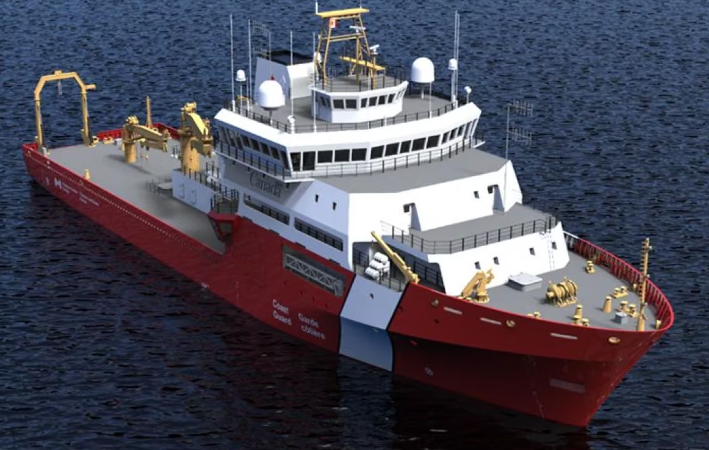Cost of Canada’s new flagship ocean science vessel jumps to $1.28B

Vessel will track climate change in the Atlantic Ocean and Gulf of St Lawrence
The budget for Canada’s new flagship ocean research ship increased 28 per cent this year jumping from $995 million to $1.28 billion.
Construction of the offshore oceanographic science vessel is underway at the Seaspan Shipyards in North Vancouver, B.C., as part of the National Shipbuilding Strategy.
It will replace the decommissioned Canadian Coast Guard Ship Hudson — now at a wreckers yard — to provide scientific and ocean mapping missions in Atlantic Canada.
The offshore oceanographic science vessel is the key platform to track climate change in the Atlantic Ocean and Gulf of St Lawrence.
Delivery is expected in 2025 and the ship will be based in Dartmouth, N.S.
The Department of Fisheries and Oceans says Public Services and Procurement Canada updated the budget this summer.
Inflation, other factors blamed for latest increase
“In June 2023, the project obtained additional build contract authorities to reflect new and updated information related to the impacts of COVID-19 to the shipyard, higher than anticipated inflation and global supply chain challenges, a more mature vessel design, and a better understanding of production and material costs,” DFO spokesperson Craig Macartney said in a statement to CBC News.

Macartney said the amount includes concept and design work, engineering and construction costs, all building materials and equipment, warranty, insurance, spare parts, training, project office costs, contingency, and contractually allowable adjustments related to labour costs, currency and commodity fluctuations. It does not include taxes.
Estimated budget has increased by more than $1B
It was originally expected to cost $109 million with delivery in 2017. Since then the price has risen more than tenfold and delivery has been moved to 2018, 2021, 2023, 2024 and now 2025.
One factor in the delay was a decision by Ottawa to move up construction on the Royal Canadian Navy joint-support vessels at Seaspan. The offshore oceanographic science vessel was supposed to be built first.
CCGS Sir John Franklin, CCGS Capt. Jacques Cartier and CCGS John Cabot have been delivered — all late — at a cost of $788-million.
There have been mistakes, nobody can deny that,” says Richard Shimooka, a ship procurement specialist based in British Columbia.
But he is willing to cut Seaspan and the federal government some slack for recent problems.

Shimooka says inflation and other pressures are hitting shipyards around the world. Canada has started its program practically from scratch.
“We don’t have the muscle memory to kind of deal with some of these issues as well as other countries do so we may have more cost increases,” Shimooka told CBC News.
In a statement to CBC, Ali Hounsell, director of communications at Seaspan, said work on the vessel is 60 per cent complete and on track for its 2025 delivery.
Hounsell said while there has been an increase in cost projections, “Seaspan has continually worked to streamline our operations and our supply chain — including in our ship construction facilities — to stay on schedule and keep costs down.
“Our ability to outfit a ship with more detailed and advanced systems early in the build process is a key driver to saving time and money. All of these efforts to drive improvements make every ship we build more efficient than the last.”
The offshore oceanographic science vessel is the largest and most complicated of fisheries science vessels built for the Canadian Coast Guard by Seaspan under the National Shipbuilding Program.
Related News
Trade war, slumping border traffic: What does that mean for the Gordie Howe bridge?
Amid U.S. President Donald Trump’s tariffs which have triggered a trade war with Canada, cross-border trips haveRead more
Trump administration threatens Harvard’s foreign enrolment, tax-exempt status
U.S. Homeland Security Secretary Kristi Noem speaks during an event on April 9, in Washington,Read more
